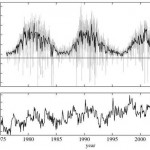How do we know the current warming trend is not caused by the sun? Here is a 3-minute video explanation from the US National Research Council.
Records of sunspot activity date back hundreds of years. These records are based on observations, not instrumentally acquired data.
In the late 1970s, satellites became a source of instrumentally recording solar output, but have not yet had the opportunity to meaningfully contribute to long term trend analysis due to their limited time scale (1).

Figure 1: Various contributors to climate change and their associated radiative forcings in 2005 relative to the start of industrial era (about 1750)
The Intergovernmental Panel on Climate Change (IPCC) has estimated the radiative forcing attributable to solar irradiation as well as other contributors. (Figure 1) Based on the data, it is believed that the Sun’s change in radiative forcing (~ 0.09 W/m2) since the start of industrial era (about 1750) is much less than that of greenhouse gases (~ 2.6 W/m2) (2). The Sun’s role in global warming will become clearer as more time passes, as longer data records will be available for study.
Figure 2 shows solar irradiance alongside global mean surface air temperature from 1975 to 2005. TSI (W/m2) is the total solar irradiance as compiled by the World Radiation Centre. T (°C) is the global mean surface air temperature departure from the 1951-1980 mean as compiled by the Goddard Space Flight Centre. (3)
This study shows that the Earth’s surface air temperature does not respond to changes in the solar cycle. While the global average temperature shows an increasing trend, solar irradiance has gone up and down with no net change and with no correlation to temperature.





